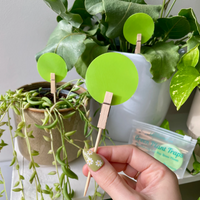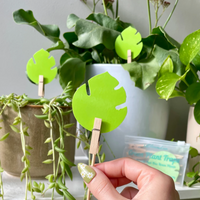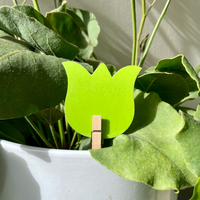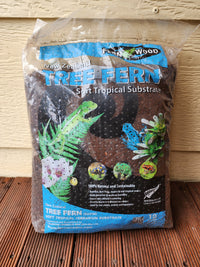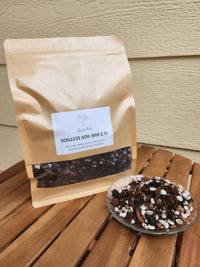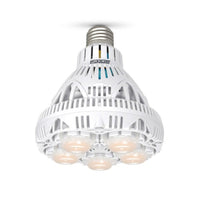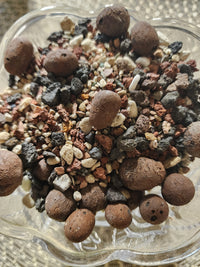NZ Fern Fibre is a fibrous growing medium derived from New Zealand tree ferns that improves aeration and moisture balance for orchid roots, preventing root rot and promoting vigorous new growth. Here, we'll explore what NZ Fern Fibre is, how sustainable Fernwood tree fern fibre is harvested, and why its physical properties—porosity, capillarity and neutral pH—make it an excellent choice for epiphytic orchids across Australian conditions. Orchid growers who struggle with waterlogged pots, compacted bark mixes or erratic indoor humidity will find practical solutions here, from substrate comparisons and root-health mechanisms to step-by-step repotting and watering guidance. You will also see how NZ Fern Fibre stacks up against orchid bark, sphagnum moss, LECA and coco coir, and which genera respond best. Practical lists, feature tables and comparison charts are included to make repotting decisions straightforward and to show when to consider Fernwood Tree Fern Fibre from Leaf of Faith SA for long-lasting, sustainable media.
What Is NZ Fern Fibre and Why Is It Ideal for Orchids?
NZ Fern Fibre is a natural growing medium made from the fibrous trunk material of New Zealand tree ferns; its structure combines high porosity with capillary water retention, so roots get oxygen and steady moisture. This mechanism supports epiphytic orchid physiology by reducing anaerobic pockets while keeping small amounts of available water near root surfaces, which improves nutrient uptake. As an outcome, orchids experience fewer root diseases and stronger root proliferation, making the medium particularly useful for indoor and sheltered outdoor culture. The next subsections define the product, outline sustainable harvest methods and detail the physical traits that matter to growers.
What Is New Zealand Fernwood Tree Fern Fibre?
New Zealand Fernwood Tree Fern Fibre refers to processed tree-fern trunk fibres prepared for horticultural use, sold under the Fernwood Tree Fern Fibre name and New Zealand Fernwood Tree Fern Fibre naming variations. The product is cleaned, shredded and sized to provide a consistent fibrous matrix that keeps air channels open while holding modest moisture through capillarity. Growers observe that the medium feels springy, resists compaction and supports anchoring of epiphytic root systems without the fines that cause soggy pockets. Understanding this identity clarifies why many Australian hobbyists prefer it over highly decomposed organic mixes.
How Is NZ Fern Fibre Sustainably Harvested?

Sustainable harvesting of NZ fern fibre follows managed-plantation protocols that prioritise regeneration and minimal ecological impact, meaning fibres are sourced from controlled growth cycles rather than wild extraction. This approach reduces pressure on native forests and aligns with buyer preferences for responsibly produced materials, especially among environmentally conscious Australian growers. The managed-plantation model supports traceability and repeatable supply while lowering the chance of habitat disturbance linked to unmanaged harvests. These sustainability practices resonate with growers who want both plant health benefits and ethical sourcing.
What Unique Physical Properties Make NZ Fern Fibre Suitable for Orchids?
Key physical properties—porosity, fibrous texture, capillary water movement and neutral pH—combine to support epiphytic orchids in cultivated settings. Porosity ensures gas exchange and oxygen to roots; fibrous texture prevents fines from blocking air channels; capillarity holds small volumes of moisture without waterlogging; and a natural pH near 5.5–6.5 supports nutrient availability. Together, these attributes result in a durable, long-lasting medium that resists compaction and decomposition, lowering repotting frequency and reducing root disturbance over time.
How Does NZ Fern Fibre Promote Healthy Orchid Roots?

NZ Fern Fibre promotes healthy orchid roots by delivering continuous aeration while buffering moisture near root surfaces, which prevents anaerobic conditions and encourages new feeder-root growth. The mechanism is simple: air-filled porosity supplies oxygen for root respiration, capillary retention provides accessible moisture between waterings, and neutral pH aids nutrient uptake—this combination reduces root stress and disease incidence. Practical indicators of improved root health include firmer, plumper roots with fewer brown, mushy zones and more active root tips. The following subsections list core benefits, explain root-rot prevention and show why balance matters for orchids.
Which Key Benefits of NZ Fern Fibre Support Orchid Root Health?
NZ Fern Fibre supports root health through superior aeration, balanced moisture retention, disease-resistance by promoting aerobic conditions, and long-term structural stability. Aeration improves gas exchange necessary for root respiration, which directly enhances nutrient uptake and growth vigour. Balanced moisture prevents waterlogging that leads to fungal pathogens while still supplying water between irrigations. Durability reduces organic breakdown that otherwise compacts and suffocates roots over repeated cycles.
- The benefits above create an environment that fosters steady root proliferation and lower maintenance repotting schedules.
- Understanding these benefits helps diagnose substrate-related root problems and choose appropriate care routines.
How Does NZ Fern Fibre Prevent Common Orchid Root Problems Like Root Rot?
NZ Fern Fibre prevents root rot primarily by avoiding prolonged saturation and maintaining aerobic conditions around roots; pores drain excess water quickly, while capillarity leaves small, available moisture films. Preventive practical steps tied to substrate properties include ensuring adequate pot drainage, allowing brief dry intervals between full waterings, and using a fibrous medium that dries from the exterior inward to discourage anaerobic pockets. These steps reduce fungal colonisation and allow root systems to recover and form healthy new roots after stress events.
- Prevention tips linked to the medium include light potting, monitored soak-and-dry watering, and routine root inspection to catch early issues.
Why Is Balanced Moisture and Aeration Crucial for Thriving Orchid Roots?
Balanced moisture and aeration are crucial because roots require oxygen for respiration and limited, consistent moisture for nutrient transport; too much water causes anaerobic conditions, and too little halts uptake and growth. Capillary retention in fern fibre supplies the thin films of water roots need, while voids in the matrix supply oxygen—this dual role supports metabolic activity and root tip extension. A practical tip is to observe root colour and turgor: firm, green-grey roots indicate balance, while brown, soft roots signal waterlogging. Maintaining this balance reduces stress and encourages regular flowering cycles.
How Does NZ Fern Fibre Compare to Other Orchid Growing Media in Australia?
NZ Fern Fibre compares favourably to traditional substrates because it combines aeration similar to coarse bark with moisture buffering closer to sphagnum moss, while offering superior longevity and sustainability claims. In Australian indoor and coastal climates, the medium reduces repotting frequency and performs well in conditions with intermittent humidity and indoor heating. The following table compares key substrate attributes so growers can make informed choices based on drainage needs, moisture behaviour and longevity.
Different substrates show trade-offs in aeration, moisture retention, pH and longevity for orchids:
| Substrate | Key Attribute | Typical Performance |
|---|---|---|
| NZ Fern Fibre | Aeration + moisture buffering | High aeration, moderate water-holding, neutral pH, long-lasting |
| Orchid Bark | Drainage | Excellent drainage, low water retention, moderate longevity |
| Sphagnum Moss | Moisture retention | High water-holding, risk of waterlogging if compacted |
| LECA | Inorganic drainage | Excellent drainage requires separate moisture buffering |
| Coco Coir | Moisture and nutrition | Good water retention, tendency to compact over time |
This table indicates that NZ Fern Fibre sits between bark and sphagnum in terms of moisture while offering better longevity than decomposing organics.
What Are the Advantages of NZ Fern Fibre Over Orchid Bark and Sphagnum Moss?
Compared with orchid bark, NZ Fern Fibre resists rapid decomposition and compaction, extending intervals between repotting and reducing root disturbance. Against sphagnum moss, fern fibre offers similar moisture buffering without the same tendency to hold too much water in fine, anaerobic mats. Practically, this means fewer root rot incidents than sphagnum and longer-lasting structure than bark, which benefits busy growers wanting reliable root health with less frequent intervention.
- These advantages translate into lower long-term substrate costs and improved plant stability.
How Does NZ Fern Fibre Perform Compared to LECA and Coco Coir?
Against LECA, NZ Fern Fibre provides better moisture buffering while still allowing airflow, so it suits growers who prefer not to manage separate capillary layers. Compared to coco coir, fern fibre is less prone to compaction and maintains air-filled porosity longer. Use-case suggestion: mix small proportions of fern fibre with LECA for mounted-style plants needing both drainage and moisture availability, or prefer straight fern fibre where organic anchorage matters.
- Mixing strategies combine strengths: LECA for drainage and fern fibre for moisture buffering, depending on species needs.
Why Is NZ Fern Fibre Better Suited for Australian Orchid Growing Conditions?
Australian indoor and coastal climates vary from dry-heated interiors to humid coastal settings; NZ Fern Fibre adapts by providing moisture buffering in drier indoor environments and aeration in humid zones, reducing root stress across scenarios. For growers with indoor heating, the medium reduces rapid desiccation; for coastal growers, it prevents prolonged waterlogging when humidity spikes. This adaptability makes it a versatile substrate choice that lowers repotting demands and supports consistent root health.
How Can Orchid Lovers Use NZ Fern Fibre for Best Results?
NZ Fern Fibre performs best when used with light potting technique, careful soak-and-dry watering and adjusted fertiliser strength to match its moisture behaviour; these practices maximise oxygen access and nutrient uptake. The medium is compatible with many epiphytic genera and works well alone or in mixes with coarse bark or LECA for specific cases. Below are repotting steps, watering/fertiliser guidelines and a species suitability list to help growers implement fern fibre successfully.
What Are the Steps to Repotting Orchids Using NZ Fern Fibre?
- Inspect and trim roots: remove dead or soft tissue and disinfect cutting tools.
- Choose a pot that allows airflow and drainage; position healthy roots and anchor lightly.
- Pack fern fibre gently around roots to maintain air channels without compressing.
- Water thoroughly after repotting to settle the medium, then allow a drying interval before the next irrigation.
These steps minimise root shock and make the most of fern fibre’s aeration and moisture-buffering characteristics.
How Should You Water and Fertilise Orchids in NZ Fern Fibre?
Watering and fertilising with fern fibre follows a soak-and-dry rhythm: saturate thoroughly, allow the top and outer matrix to dry partially, then repeat to maintain capillary films without waterlogging. Adjust fertiliser concentration to slightly lower than for dense mixes, using diluted feed at half-strength during active growth and reducing it in dormancy. Observe roots for turgor and use visual cues—firm, plump roots indicate appropriate watering—then tweak frequency according to indoor humidity and temperature.
- Practical rule: aim for accessible moisture between waterings rather than constant wetness.
Which Orchid Species Thrives Best in NZ Fern Fibre?
NZ Fern Fibre suits epiphytic genera that prefer airy, moisture-buffered substrates, including Phalaenopsis, dendrobium and many cymbidiums when grown in sheltered conditions. Phalaenopsis benefits from the stable moisture films near root tips; dendrobium species appreciate the aeration for cane-root systems; cymbidiums can use mixes with coarser components for cooler growers. Terrestrial orchids or cool-growing specialists may need adjustments or blends to meet specific moisture and temperature preferences.
Why Is NZ Fern Fibre the Sustainable Choice for Australian Orchid Enthusiasts?
NZ Fern Fibre is positioned as a sustainable option because managed-plantation harvesting reduces ecological disruption compared with wild-collection methods, and the product’s longevity lowers waste from frequent repotting. These environmental advantages align with long-term care benefits: fewer substrate replacements, lower resource use and consistent plant health that reduces losses. The following table summarises environmental and lifecycle attributes to show why many growers select Fernwood Tree Fern Fibre for sustainability and performance.
Sustainability attributes and lifecycle benefits of NZ Fern Fibre:
| Attribute | Characteristic | Environmental/Practical Value |
|---|---|---|
| Sourcing | Managed-plantation harvesting | Reduced wild-harvest impact, traceable supply |
| Durability | Resistance to compaction and decomposition | Fewer repottings, less waste |
| Material | Natural fibrous organic matter | Biodegradable end-of-life, lower synthetic inputs |
How Does Sustainable Harvesting of NZ Fern Fibre Benefit the Environment?
Managed-plantation protocols for fern fibre reduce pressure on wild ecosystems and support renewable production cycles, lowering biodiversity risks associated with unmanaged extraction. For Australian buyers who prioritise ethical sourcing, such practices mean the substrate choice contributes to conservation outcomes while still delivering horticultural benefits. Choosing a responsibly harvested medium helps align daily growing practices with broader environmental values.
What Makes Fernwood Tree Fern Fibre an Eco-Friendly Orchid Potting Mix?
Fernwood Tree Fern Fibre’s eco-friendly features include natural composition, long lifespan in cultured pots and sourcing models that prioritise regeneration; together, these attributes reduce the frequency of replacement and associated transport impacts. By lasting longer than rapidly decomposing organics, the medium reduces material turnover and waste, which is an important lifecycle advantage for sustainability-minded growers. Reduced repotting also lowers plant stress and the resource inputs required for repeat cultivation cycles.
How Does Choosing NZ Fern Fibre Support Long-Term Orchid Care?
Selecting NZ Fern Fibre supports long-term orchid care by combining plant-health benefits with cost and labour savings: durable structure means fewer repottings, healthier roots reduce losses, and neutral pH supports steady nutrient uptake over seasons. For growers interested in both performance and sustainability, products such as New Zealand Fernwood Tree Fern Fibre are available in various convenient sizes through Australian online retailers like Leaf of Faith SA. These purchasing options make it straightforward to trial the medium or stock up for repeat use.
- Practical takeaway: a durable, sustainably sourced medium can lower the total cost of ownership while improving plant outcomes.


